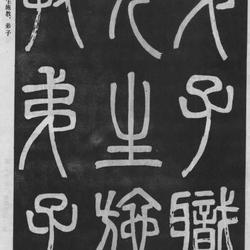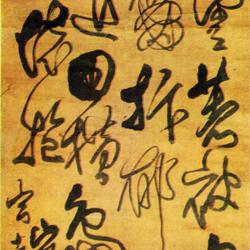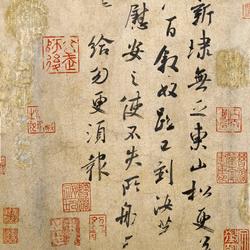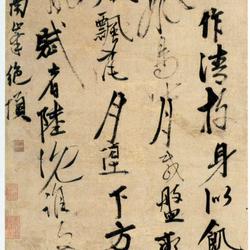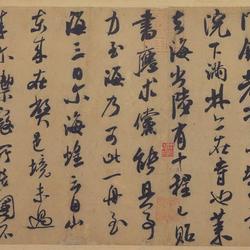The full name is "The Monument of Emperors of the Tang Dynasty Waiting for Ci Temple". Ancient writings by Yanshi of the Tang Dynasty. There is no name of the person who wrote the book. There is no date or month when the monument was erected. Song Zhao Mingcheng's "Inscriptions and Stones" believed that it was completed in the second year of Zhenguan (628 AD). Wang Chang's "Inscriptions and Stone Collection" of Qing Dynasty was written in the third year of Zhenguan. However, Fang Ruo et al. believed that it was probably completed after the eleventh year of Zhenguan (637 AD). . In Sishui County, Henan (now Rongyang County, Henan). It is one foot and four inches high and four feet and six inches wide. It has regular script, thirty-two lines and sixty-five characters. There are nine characters in Eyangwen seal script. The stele records that Emperor Taizong of the Tang Dynasty (Li Shimin) defeated Wang Shichong and Dou Jiande and built a temple at the battle site to commemorate the fallen soldiers. At the end of the 32nd line of this stele, there is a word missing under "Yan Shigu Fengchi". Is it "Book"? Is it "written"? unknown. It is logical that it is "written", but people speculate that it may also be written by Shi Gu.
Wang Peng of the Qing Dynasty commented: "The calligraphy is exquisite, with Ding Daohu at the top and Xu Lihai at the bottom. It is smooth and smooth, which makes people think." Yang Shoujing's "Ping Stele Notes" said: "The structure is all the same as that of the Wei people, but the posture is full of energy and vigor. The strength is extraordinary, there is no weak stroke, and he can stand up to Ou (Yang Xun) and Yu (Shi Nan)."
The word "wu" at the beginning of the inscription "Shi Feng Wu Wu" was added before the Jiaqing period of the Qing Dynasty. During the Daoguang period of the Qing Dynasty (AD 1921-1850), additional postscripts were engraved. Those without postscripts are old rubbings. In the early Qing Dynasty, there were two types of rubbings: special rubbings and ink rubbings. There are no rubbings handed down from generation to generation before the Ming Dynasty. Recently, some publishers have been reluctant to cut and frame the work upside down. The last line "Secretary, Major Superintendent, Qingche Duwei, Langya County" is mistakenly posted as "Secretary, Major Superintendent, Qingche Duwei, Langya County". The mistake may be the lack of writing in the cutting and mounting process.
The calligraphy of this stele is mainly based on the Northern Wei Dynasty, but it also has the legal requirements since the Sui Dynasty and the Tang Dynasty. The writing style is clear and vigorous, the strokes are smooth and sharp, the strokes are convenient, the lifting and pressing are not obvious, and the corners are clear. The structure is horizontally flat and wide, and the strokes are arranged to highlight the artistic effect of parallel contrast. Therefore, it has both a dense and vigorous spirit and a uniform and energetic style, which is another style in Tang Kainzhong. Because it has been covered up by the requirements of "guange" for a long time, it has not been promoted. In fact, starting from this point, Xi Kai can be traced back to the elegance and elegance of the Sui, Chen, and Northern Wei Dynasties, and can also be traced back to the elegance and elegance of the late Tang Dynasty. To put it bluntly, even if you are doing hard-pen calligraphy, it is very appropriate to use this as a model. I hope enlightened teachers will pay attention to this.
Appreciation of works:
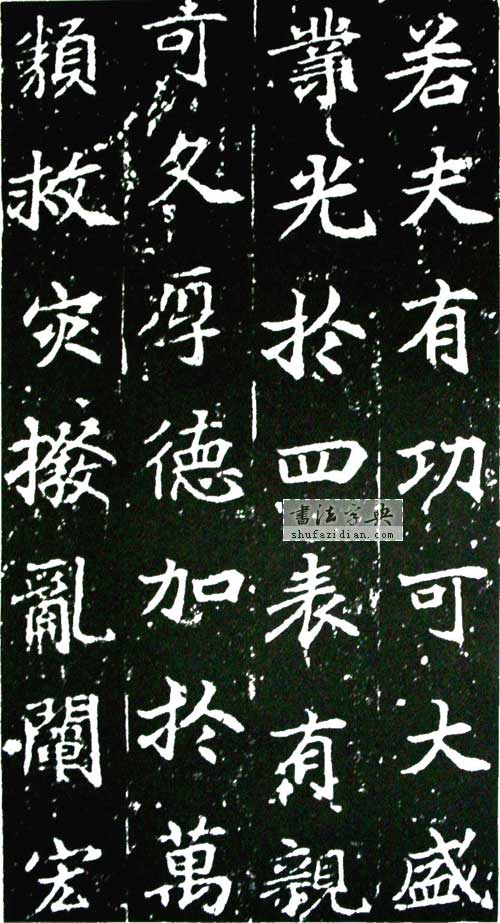
Relevant literature records:
Ouyang Xiu's "Collection of Ancient Records Postscript Volume 5" [Tang Yan Shigu Dengcisi Monument "The Second Year of Zhenguan"]
Right "Dengci Temple Stele", written by Yan Shi in ancient times. The temple is located in Sishui, Zhengzhou. Emperor Taizong of the Tang Dynasty defeated Wang Shichong and Dou Jiande, so he built the temple at the battle site, which was said to be a blessing to those who died in battle. In the early Tang Dynasty, there were many places where thieves were defeated by soldiers, and most of them built temples. The heroes and wisdom of entrepreneurial kings since ancient times are unparalleled by others. To the extent that he has outstanding faith in the Way and knows its meaning, it cannot be achieved except by those who have accumulated knowledge and are sincere and enlightened. Taizong's heroic wisdom, the master of the world, but he was confused about the shortcomings of customs, and he still worshiped the illusory figures. How can it be said that his words are infinitely eloquent and he is good at physics? Since ancient times, treacherous words have been used to confuse listeners, even if a wise person is not immune. But it is pleasant, but it can deceive people. Therefore, in this book, I ridiculed those who are involved in many loves, calling it this. Written on the day after Qingming in the first year of Zhiping.

